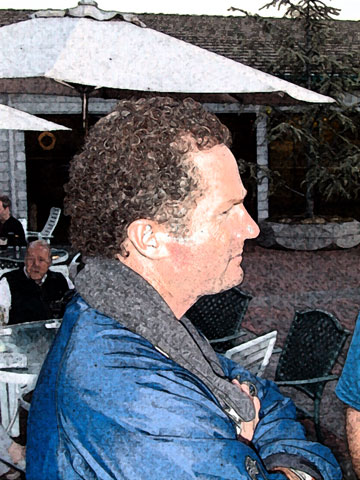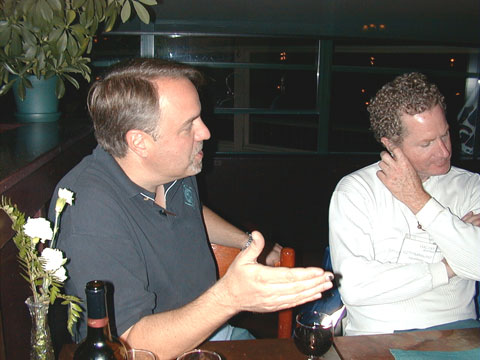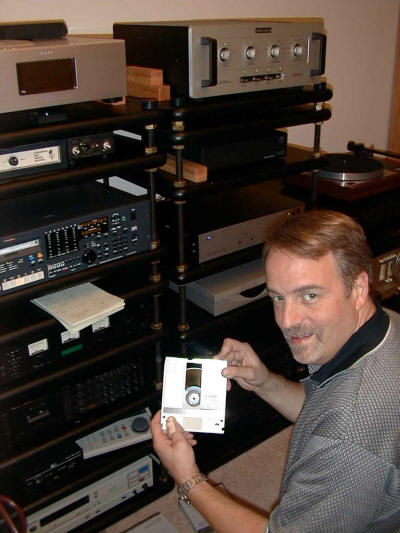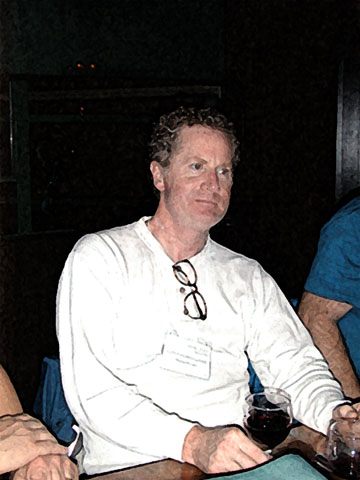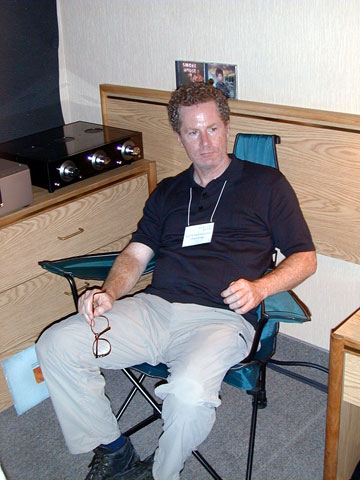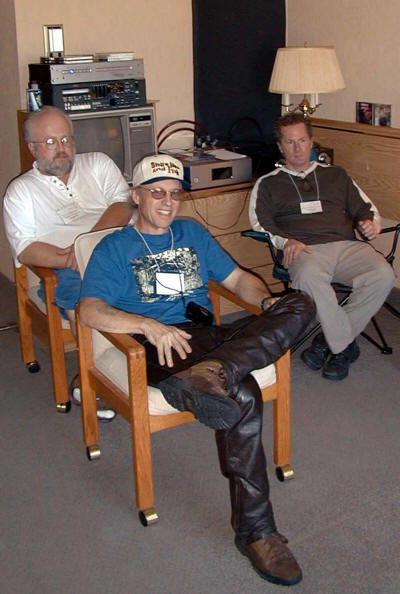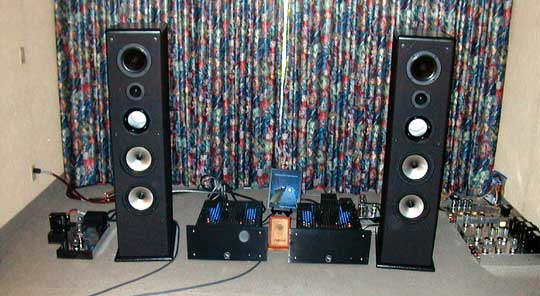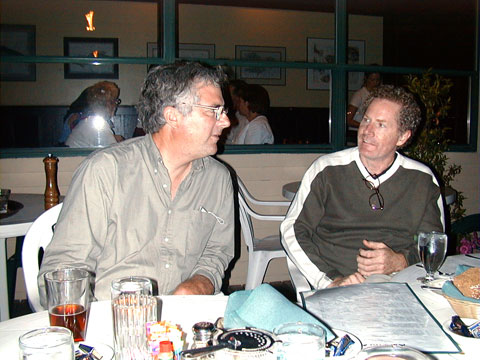|
You are reading the older HTML site
Positive Feedback ISSUE
14
From the
Archives of Positive Feedback: An Interview with Scott
Frankland
All photographs, image processing and effects by Robinson. In Positive Feedback Vol. 9, No. 3, we published a conversation between PFO's Mike Pappas and Scott Frankland, one of the best fine audio engineers in the world. His work includes world-class designs at MFA (e.g., the MFA MC Reference and Luminescence preamps) and Wavestream (the Wavestream V-8 amplifier). After VSAC 2001, Mike talked with Scott about some newer work that Scott was doing in the fall of 2001, along with tube technologies, tube design, feedback, and other interesting things. The main difference between the print version of this interview in PF and this version in PFO is the fact that we are at last able to publish accompanying photographs—and in color.
Scott Frankland at VSAC 2001 (fresco by Robinson) Pappas: Scott, I pulled Positive Feedback Vol. 5, No. 5 and have read the V8 article about 5 times now. I am trying to understand how a guy who NEVER liked how tube amps sounded could be so knocked out by what I heard at VSAC (STUNNED is a better term). The more I re-read the V8 treatise, the more I understand what makes them so special. Frankland: Thanks, Mike. Just remember these key words: brown-base… black-plate… clear-top… Pappas: Diamond-bottom? Frankland: You catch on quick. Pappas: Scott, I recall that this amp was running 80 watts using 8 EL34's in triode mode. Frankland: I'm going to rate the amp at 75W nominal. Power at clipping is 125W. This is a far cry from the 300W, 6550 V8. Pappas: Why the change to EL34's? There seems to be a huge power penalty. Frankland: Because an EL34 amplifier has the potential for less distortion than a 6550 amp. Pappas: What's so special about the EL34? Frankland: For one thing, the EL34 is a true pentode. The 6550 is a beam tube. They have different conductance curves and therefore different distortion characteristics. RCA and Philips carried on a sophisticated debate in the '30s over which technology was better. Although the 6550 can produce more power than the EL34, the EL34 needs less driver swing than a 6550 at any given power level. This means less distortion contributed by the driver stage. Pappas: So you're going for lower distortion in this new amp? Frankland: I'm going specifically for lower high-frequency distortion. Pappas: What was your reference speaker for this project? Frankland: I needed a speaker with natural yet revealing highs, so I chose the Avalon Eidolon's as my primary reference (which is what you listen to). As a further test, I used the Von Schweikert DB100's to "magnify" the amp's sound at the milliwatt level. Pappas: As I recall, you used the Sound Lab's as your reference when you designed the 6550 V8. Frankland: Right. The 6550 V8 was designed to drive difficult loads, such as the big Sound Lab's. When played loud, the Sound Lab's draw enormous current at high frequencies.
Positive Feedback's Mike Pappas (left) with Scott Frankland at a PF dinner, VSAC 2001 Pappas: How can we be sure that an amplifier is able to handle this kind of load? Frankland: Besides bench testing, I use a track called "Fire and Water" from the Free album of the same name. This pink Island LP is so smooth you can blast it at 110dB and it won't burn your ears. During "Fire and Water" a long fuzz-guitar sustain is played. This type of sound contains high-frequency harmonics at high levels. The Sound Lab's can easily draw 7A under these conditions. Pappas: I take it the EL34 V8's have trouble driving the Sound Labs? Frankland: They are on the margin. The saving grace of the EL34 V8 is its clipping characteristic. There is no loop feedback in this amp. This results in a deceptively powerful-sounding amplifier. Pappas: How does feedback affect clipping? Frankland: The more feedback we use, the harder the clipping. The basic rule with a feedback amp is that you never want to run out of power. Pappas: Is that why you decided to eliminate feedback from your amp? Frankland: Soft clipping provides a small amount of headroom, nothing more. Since headroom can be obtained by other means, I don't see clipping as a make or break factor in amplifier design. There is another problem with feedback that is far more concerning. Pappas: And that problem is…? Frankland: That problem is harmonic multiplication. Pappas: Could you explain what that means? Frankland: When we apply feedback around a circuit we create a path for harmonic distortion products to loop through the amplifier. At each pass they intermodulate with the audio signal, creating sum & difference products at the output. Pappas: How is this different from ordinary IM distortion? Frankland: Ordinary IM distortion creates a finite number of sum and difference products. With recirculation, however, the IM products have the potential to multiply themselves to infinity. This was analyzed by Baxandall in the late '70s. Pappas: How is this possible? Frankland: Let's say we have an amp that produces purely second-order distortion—a triode amp at low power levels, for example. When 2f loops around, it intermodulates with 1f (the fundamental) to produce 3f; 3f then loops around to produce 4f; and so on. This repetitive looping generates a flood of high-order products that runs through the circuit like bad adrenaline. Pappas: That sounds ugly. Frankland: And that is the main reason why feedback has become so unpopular lately. Pappas: So harmonic recirculation turns out to be a fundamental flaw in feedback theory? Frankland: Feedback per se is not inherently flawed. This becomes apparent once we understand what makes feedback turn ugly. What is flawed is the active device around which feedback is applied. Baxandall showed that, although feedback converts low-order products to high-order products, the feedback still acts to reduce the overall distortion.
Mike Pappas in Robinson's listening room with one of his incredible jazz recordings on DSD Magneto-Optical DSD master discs, in front of the Genex 8 channel DSD recorder/playback unit, October 2001. Needless to say, DSD master discs in the listening room was an exceptional treat, and showed me once again the magnificent potential of this format, properly handled. Pappas: But if feedback multiplies the order of harmonics to infinity, how can it reduce products at infinite frequency? It sounds to me like the old kill one and two take its place routine. Frankland: It doesn't quite work that way. As we apply more and more feedback, the low-order products will approach zero. The recirculation products will then converge to zero. At that point, there will be vanishing products left to intermodulate. Pappas: But how do we know when high-order products are small enough to be inaudible? Frankland: Let's make this practical. If feedback can be made to reduce the recirculation products to a level below that of the open-loop amplifier, then I would say that feedback's job is finished. This, I think, is a key criterion for any feedback amp. Pappas: It sounds to me like you're saying we need to use more feedback, not less? Didn't the transistor guys try that once during the specs wars? Frankland: They did, but if you recall they only told us the distortion at 1kHz, or with the amp driving 8-ohm power resistors! Pappas: Why, then, do so many designers argue for smaller amounts of feedback? Frankland: Applying small amounts of feedback is actually the worst case. The feedback, in this case, will create recirculation products but will be insufficient to reduce them. Pappas: But won't more feedback cause TIM problems? Frankland: TIM will not be an issue so long as the stage receiving the feedback does not overload with a worst-case feedback signal. It's just that simple. Pappas: How do you define a worst-case feedback signal? Frankland: The worst-case feedback signal will always be less than or equal to twice the level of the amplifier input sensitivity. This was explained by Garde and Cherry in the late '70s. This margin against overload is not difficult to achieve with tubes. Again, the problem is not feedback, it is inadequate headroom in the feedback receiving stage. Pappas: So what's to prevent us from applying more feedback? Frankland: Unfortunately, small amounts of feedback are all we can get with conventional tube amps, due to limited open-loop bandwidth. This limited bandwidth creates phase shift near the audio band, which forces us to limit the feedback. If we fail to do this, the amplifier becomes unstable. Pappas: How does phase shift affect stability? Frankland: To be effective, feedback must track the input signal inversely. At some high frequency the feedback will accumulate 180° of phase shift and will "uninvert." We are forced to reduce the amplitude of the feedback to unity at this frequency, otherwise we risk oscillation. Pappas: What can be done about this? Frankland: There are three solutions to this problem. Two of these solutions are fantasies, but they best illustrate my point. Pappas: I'm all ears. Frankland: The first solution is to create a distortionless open-loop amplifier. In such an amp there will be no harmonics to intermodulate, and therefore no harmonic multiplication when feedback is applied. This fact alone should give us pause to rethink feedback as not inherently flawed. Pappas: I think I'm beginning to see what you mean. Frankland: What seems to get lost in the feedback debate is this one critical fact: harmonic multiplication occurs only when feedback is applied around a nonlinear circuit. The more linear the open-loop circuit, the more blameless the feedback. Pappas: So we should really be faulting the active device—with its limited bandwidth and nonlinear gain—rather than the feedback. Frankland: Feedback is nothing more than a path by which the audio signal communicates with itself. This path is not the fault, the fault is the amplifier itself. Pappas: And what is the second solution?
Scott Frankland enjoys a glass of wine at a Positive Feedback dinner, VSAC 2001 (fresco by Robinson) Frankland: The second solution is to design an amplifier with infinite bandwidth. Infinite bandwidth means no roll-off and therefore no phase shift. This allows us to apply infinite feedback (assuming infinite open-loop gain). Applying infinite feedback will reduce, to an infinitesimal level, all distortion products, including multiplicative products. Thirdly, we can design real-world circuits with less dependence on feedback. This places a burden on the designer to use techniques optimized for linearity. This is one of the hottest trends in tube audio today. Most of these techniques will be expensive and inefficient, such as class-A circuits; mu-followers; current-sources; choke-loads; etc. But what else can we do? The first two solutions, after all, are impossible. The third solution is the only practical one. Pappas: But if good, linear circuits can be designed without feedback, why use it at all? Frankland: Strange, isn't it? It's like at the bank. The more we need a loan, the less likely we are to get one. It's the same with feedback. The more we need it, the less likely it'll do us any good. But even linear circuits can benefit from feedback, because feedback improves damping. Pappas: So how do we obtain damping if we don't use feedback? Frankland: The price for more damping is more tubes. Without feedback, damping will be marginal at best unless several tubes are paralleled in the output stage. Each time we double the number of tubes in parallel, the internal amplifier impedance is cut in half. What I've done in the V8 is to use enough output tubes in parallel so that damping is adequate without feedback. Pappas: So where does that leave the typical tube amp? The vast majority of tube amps use only one or two output tubes. Frankland: The Achilles heel of the typical tube amp is the output transformer. Even the best transformers don't provide adequate bandwidth for sufficient feedback. By sufficient, I mean sufficient to reduce all high-order products (caused by recirculation) below the level of the open-loop amplifier. Using small amounts of feedback is not an option since this will produce more high-order distortion than we get open-loop! Pappas: So what I hear you saying is that there is just no way to increase feedback in a conventional tube circuit. Frankland: I'm saying that it's extremely difficult to apply sufficient feedback in a conventional tube amp. To get sufficient feedback I think we have to turn to unconventional tube circuits—circuits with wide open-loop bandwidth. Sufficient bandwidth will support sufficient feedback. A very linear OTL might allow this; or a cathode-follower amp. A conventional tube amp with multiple feedback loops might also allow the use of sufficient feedback. Pappas: So where does that leave us in the feedback wars? Frankland: To make progress with conventional tube circuits, our best option may well be to eliminate loop feedback. To use feedback effectively, we need open-loop circuits that are not only wideband, but very linear. This puts the burden on the open-loop design rather than on the feedback. Pappas: Multiple output tubes would seem to be the way to go in zero-feedback amps. Why don't more designers do this? Frankland: Because they are more concerned with simplicity; parts count; or economy, would be my guess. By so choosing, they become less concerned about damping. Pappas: What are some of the problems designers face in using multiple output tubes? Frankland: I would cite the article on paralleling tubes in Glass Audio Vol. 12, No. 5. The author's explain what's needed to get tubes "in synch." Another snag is input capacitance. Every tube has an input capacitance that becomes additive when we parallel tubes. This problem is especially marked in triodes. Every time we double the number of tubes, we also double the input capacitance. High input capacitance not only rolls off the top end, it also loads down the driver at high frequencies. Pappas: Is there any way around this? Frankland: A conventional driver circuit can handle this job, up to a point. But if we want to use multiple triodes in parallel, we face high input capacitance. In the V8, I place a small power tube, a 12GN7, between the driver stage and each output tube. The 12GN7's provide more than enough current to drive the triode input capacitance. I call these auxiliary power tubes "grid superchargers." Pappas: Is that the gist of your patent? Frankland: It's one aspect of it. My patent has a number of claims, but there is really only one key idea, which is to set up a one-to-one correspondence among the output tubes and the "superchargers." Pappas: This is like taking the twin-turbo idea to the extreme of one turbo per cylinder. Frankland: As a matter of fact it was this explicit one-to-one correspondence that allowed me to push the idea through the patent examiner. What finally convinced him is that this solution permits an indefinitely powerful high-fidelity triode amplifier. Pappas: Indefinitely powerful? Frankland: Yes, because the power potential is open-ended. Basically I can go on adding as many tubes in parallel as I choose. There is no penalty due to additive input capacitance. I can build a 5000W triode amp using EL34's with no loss of bandwidth and no increase of high-frequency distortion. That's the gist of my patent.
Frankland in the Wavestream/Cardas/Von Schweikert/Hovland room at VSAC, 2001; sources were the Genex DSD 8-channel recorder/playback unit using Mike Pappas master DSD discs, and a Sony SCD-1 Pappas: Impressive. I think I already know the answer to this next question, but why don't more manufacturer's publish their high-frequency distortion figures? Frankland: Because it would be too embarrassing. Pappas: Ouch! Frankland: But if you ask them why not, they'll just respond with something like: "Specs are not a reliable indicator of what we hear." Pappas: Do you think specs will ever be reliable? Frankland: Let me put it this way. A lot of our cheap consumer hi-fi equipment has improved over the years as a result of toughening the specs. Manufacturers don't sit around tweaking car radios and rack systems, changing this wire or that capacitor, and yet consumer audio gets better sounding each year. What's happening is that this equipment is being built to a tougher spec. Not just low THD, but low THD across the audio band. Pappas: IC's seem to be getting better, too. Frankland: Without question. Just look at the success of the 47 Labs' stuff. Or the Black Cube. With IC's, the same rule applies: if we can improve the open-loop design, the IC will sound better when we apply feedback. Pappas: Do you think amplifiers will always sound different? Frankland: You know, there may well be a perfect (or near-perfect) amp available right now. But I don't think it would ever be accepted as such, because there is no perfect loudspeaker by which to confirm it! We have this wild card called amp/speaker synergy. So long as loudspeakers remain imperfect, the perfect amplifier will take a back seat to a more synergistic amp if the synergy makes our speakers sound better. Pappas: So you don't think amplifiers will one day all sound the same? Frankland: Given a high enough standard for our specs, I don't see why not, but I doubt it will happen anytime soon. One problem is power wars. Everybody wants to show how powerful their amps are, yet the manufacturers aren't willing to disclose what happens to their amps under adverse conditions. Pappas: How do you define "adverse conditions"? Frankland: When a speaker passes through its impedance minimum, the amplifier should deliver current without loading down. This means keeping some power in reserve. This reserve power doesn't show up in the rated power spec. It only shows up under duress.
Left to right: PF's Rick Gardner, Ian Joel, and Scott Frankland listen to Mike Pappas' DSD recordings in the Wavestream room at VSAC 2001 Pappas: So how do you design reserve power into a tube amp? Frankland: By tuning the power characteristic curve. This is the curve of power vs. load impedance. For example, instead of designing for maximum power into an 8-ohm resistor, we can design for optimum power into a real loudspeaker. The problem is, which loudspeaker? There is no such thing as a standard loudspeaker. As a start, we can simply design for an impedance minimum of 4 ohms driven from the 8-ohm tap. That way, if a nominally 8-ohm speaker has a 4-ohm impedance minimum at, say, 100Hz, the amp will not come unglued at 100Hz. It can still deliver clean power. This is a matter of juggling the output transformer impedance. The downside is that it trades off the rated power spec. Pappas: So if a tube amp is designed without reserve power it's liable to sound markedly different on different speakers? Frankland: Correct. This is something that goes beyond mere damping. It's an impedance vs. power function as seen through the output transformer. What we need to know is how the amplifier behaves when the load increases and decreases at different frequencies. It's like the torque vs. horsepower curve of an engine at different rpm's. You don't want the torque rolling off before the horsepower kicks in. Anybody who builds engines will provide this information. It's what allows us to match an engine to a car. Pappas: That seems like pretty basic information. Frankland: On the other hand, I'm sure a lot of audiophiles won't care at all. They are looking for a more beautiful midrange, for more involvement, or for more goose bumps. They can accept other problems in exchange for what they want. But those of us interested in a more orthodox concept of high fidelity should be concerned. Pappas: What is your concept of high fidelity? Frankland: I think the standard concept of high fidelity is very straightforward. High fidelity is the pursuit of replication. We want to hear exactly what was heard in the recording studio or concert hall. It is audio fidelity as opposed to audio impressionism. If we want to optimize a catalog of records, such as the "Living Stereo" catalog, we can do that. We can become audio impressionists. In this case we are using the "sound" of an amplifier to invert the defects, as it were, of a given recording heard through a given loudspeaker. But that's not high fidelity, it's synergy. We can't get replication by this means. In the strict sense of high fidelity, an amplifier must not have a "sound." A musical instrument has a sound. The amplifier's job is to replicate that sound. Any "sound" in the amplifier is a residual product. Progress will depend on rooting it out.
The Wavestream room at VSAC 2001: Speakers by Von Schweikert, cables by Cardas, preamplification by Hovland, and amplification by Wavestream, all playing back pure DSD master discs. Scott's EL-34-based V-8 amps are between the speakers. To the right are a pair of Wavestream SET monoblock amps. Pappas: But is replication really possible? Frankland: It's approachable. The simple fact is, if we don't have flat 20kHz bandwidth we can't approach a live musical performance. No way. Go stand next to a drum kit and listen to the crash cymbal. The crash cymbal creates an envelope of sound that radiates outward in all directions. It's uncanny. The harmonics just seem to go on forever. That quality is elusive as hell in a hi-fi system. The only way to get manufacturers to come clean is to insist on knowing the gain ratio at 20kHz. This is easily measured. There is no subjective element here at all. Stating that an amplifier is –1dB at 50kHz looks impressive, but it's really a cop-out. We need to know the loss at 20kHz. Is it 1dB? Half a dB? A quarter? I think it should be less than a quarter—preferably within a tenth. Now we can hear the correct harmonic relationships out to the limits of our perception. At least potentially. Without a flat bandwidth to 20kHz (at least), there is no such potential. Again, the big bottleneck is the output transformer. The transformer I use in the V8 is less than 0.1dB down at 20kHz. It's also expensive. That's the downside of flat response. Pappas: As you say, I find that a lot of audiophiles simply don't care about wide bandwidth. It's almost as if they prefer listening to a rolled-off amp. Frankland: These folks are trying to airbrush the centerfold. The midrange may sound better on many recordings, but this is not replication, it's impressionism. At worst, it's a band-aid for poor design. How can we know if we've got the midrange right if there are no highs? Pappas: Good point. Frankland: But extending the bandwidth to encompass our entire range of perception is perilous. There are some physical impediments on the hardware side, and some psychoacoustical impediments on the listener side. This was recognized early on. There were a lot of listening tests done in the '40s by people like Olson, Shorter, and Fletcher. These tests revealed that the average listener would not accept extended bandwidth unless the high-order distortion could be kept within certain limits. Pappas: So a flat 20-20k bandwidth is really just a start. Frankland: My view is that an audio amplifier ought to provide clean power across the entire audio spectrum. This means rating the power of an amplifier at 20kHz rather than at 1kHz, as is commonly done. If an amp can't produce clean power at 20kHz, I believe that is cheating the consumer. How else can we be sure that an amp can drive, for example, the Sound Lab's? Pappas: The usual way is to hook it up and listen. Frankland: It would be so much simpler if we could just look up the figures and winnow down the final candidates for audition. Pappas: But that would deprive audiophiles of the joy of the hunt! Frankland: Personally, I'd rather get it over with so I can sit down and listen to music! Pappas: So really you are advocating more than just flat response to 20kHz. You are advocating clean power bandwidth across the whole audio spectrum. Frankland: That is the challenge I present for the coming decade. The movement among tube designers toward greater linearity is a sign that people have grown tired of relativism in audio. Pappas: Clean power bandwidth is something that tube designers have always struggled with, is it not? Frankland: It's a huge challenge. With wide bandwidth amplifiers, we create more room for distortion to creep in, and it just gets worse as we go up in frequency. This is basically why I began experimenting with zero-feedback amps. In any well-designed zero-feedback triode amp there is no need to roll off the highs to get the midrange right. The highs are already clean! This rolling of the highs is a compromise that I think we need to get beyond in the tube world. I just hope I can make a small contribution to this effort. Pappas: Pricing is about 16K per pair, is this correct? Frankland: That's the projected retail price, yes. Pappas: You also mentioned a pentode amp that's under development. Frankland: I plan to offer a Pentode V8 after I decide on 6550's or EL34's for the final product. I have yet to build an EL34 in pentode, however. I won't decide until I finish my experiments with both tubes. So far I've built 6550 V8's in triode, ultralinear, and pentode; both with and without feedback. I want to do the same with the EL34. Pappas: That's a pretty comprehensive program you've embarked upon. Frankland: It goes back a ways. The first phase of my comparison of 6550's and EL34's was purely theoretical. It ended with a research paper I published in Glass Audio (11:5, 1999) and V&T News (Dec 1999). This paper looks at the technical debate between RCA and Philips. The second phase, which is currently in process, is the experimental and listening phase. One aspect of this phase involved my participation in a listening comparison of EL34's. The results were published in Vacuum Tube Valley (#16), in which 14 NOS and current production EL34's were compared. A 6550 shoot-out is also planned.
George Cardas and Scott Frankland, long-time friends, at the PF dinner on the first night of VSAC 2001 Pappas: Do you really think a pentode can compete with a triode for sound quality? Frankland: Not a pure pentode, no. But if we use the high pentode gain as local feedback, a funny thing happens: the pentode turns into a virtual triode! The feedback shifts the plate curves of the pentode, normally horizontal, into a vertical position. This indicates low internal impedance. With certain pentodes the resulting plate curves can be more linear than a natural triode! That's why I think a pentode has the potential to sound more neutral, although perhaps less "beautiful," than a triode. Pappas: How about the rest of the system you demo'ed at VSAC? I tried to find information on the VSR speakers with the built in sub-amp but their web site has no information. Frankland: The speakers are too new to be on the website is my guess. They are Albert Von Schweikert's DB100's (100dB @ 1W/1m). The tweeter is a 1" silk dome using partial horn loading and ferrofluid cooling. There is also an ambience tweeter (adjustable) on the back panel. The midrange is a 6" cast frame with a 72oz magnet. The cone material is Aerogel (a composite of carbon fiber powder, chopped Kevlar fibers, and cellulose binder). The woofers (2) are 8" cast frame with 900W peak power capability. They are loaded into a triple-chamber transmission line with a tuned 20Hz port. There is a built-in 600W amp that takes its signal from the main amp in order to preserve coherence. The dimensions are: 54"H X 12"W X 22"D. Weight is 200lbs each. Pappas: What was the preamp that you were using? Frankland: The Hovland HP-100. The cables were all top-of-the-line Cardas (thanks, George!). Pappas: Why didn't your amp blow-up at VSAC? I noticed you pulling out George's interconnects with the speakers disconnected! Frankland: I'm a big believer in "idiot-proof" products. A stable design should take idiotic behavior into account (even when the designer is acting like an idiot!). Second, I derate all parts according to a Norton/Thevenin model. The failure mode now becomes worst-case. In the first step, each tube is open-circuited. This allows the DC voltage to rise to its peak maximum. The parts must be rated to withstand this voltage. In the second step, each tube is short-circuited. This allows the DC current to rise to the peak maximum. The parts are also rated to withstand this condition. Those parts that can't be protected in this way are fused. In other words, if a tube blows up, gets stepped on, or otherwise gives up the ghost, the V8 will not go down in flames. The same goes for signal voltages and currents. If the amp is run without a load, or if the interconnects are pulled out during play, the amp will not go down. The only thing likely to blow up in the V8 is tubes. But this can happen to anybody. In this sense, the V8 is plug-and-play. Pappas: Why do tubes blow up? Frankland: Well, they don't actually blow up, they just arc-over and die. Pappas: For no good reason? Frankland: The usual cause is excessive screen voltage. Pappas: Can anything be can be done about that? Frankland: Manufacturers can start respecting the limits published in the tube manuals. This respecting of the manuals was common during the golden era. Pappas: But aren't some brands more rugged than others? Frankland: True. There is a great variation among tubes in this respect. But there is also a great deal of consistency in the tube manuals with respect to operating voltages. So it's largely empirical. The problem is that if we design our amp with a rugged tube, operating at the edge of its capability, what do we do when that tube is no longer available? Pappas: It would almost make more sense to design tube amps to operate with the lowest common denominator. Frankland: There is a fairly simple solution to this dilemma. In the 6550 V8, I include a B+ switch that allows the owner to switch the operating voltage up or down depending on the brand of tube he's using. When the B+ switch is set to a higher position, more power is obtained. If this proves to be stressful for a particular brand of tube, the switch can be turned down. This also gives the owner the option of prolonging his tube life. Pappas: Considering the state of the economy, that might not be such a bad idea. Frankland: When I set out to design the V8, I chose output tubes that are cheap and readily available. Tubes, after all, wear out. And when we have sixteen of them to replace, this becomes a real issue. Pappas: So where does the V8 fit into the brave new world of SET amps? Frankland: The philosophy behind the V8 is far removed from the single-ended credo, which places a much bigger burden on the loudspeaker. With SET amps we need a speaker that's not only efficient, but also well damped. But that's what makes for choices. I'm simply providing a product for people whose preferences drive them to purchase large, difficult loudspeakers. I'm happy to fill this niche. Pappas: So when can you ship me a unit for review? Frankland: Mike, you are first in line as soon as they go into production. Pappas: Thank you, sir. Frankland: Not at all. Thank you, sir.
|

